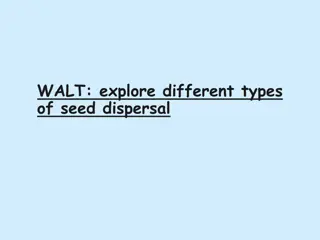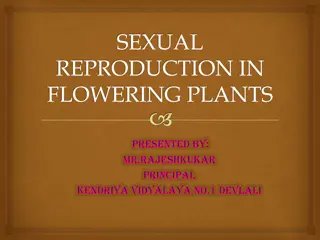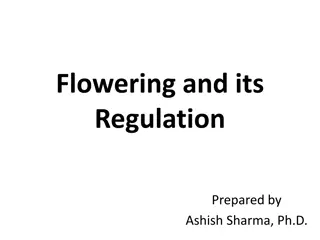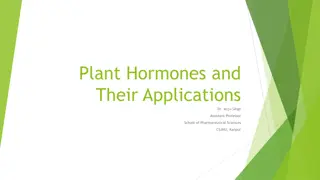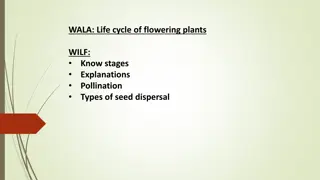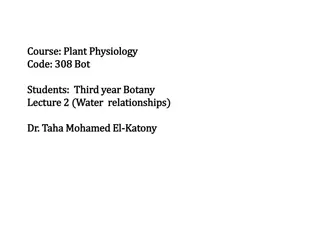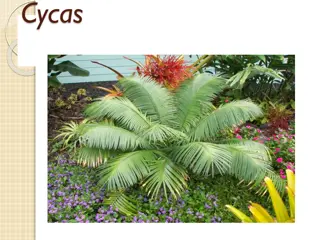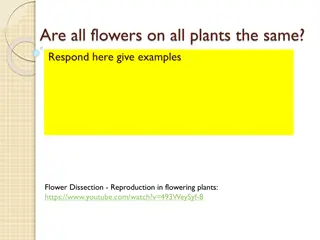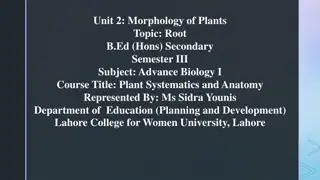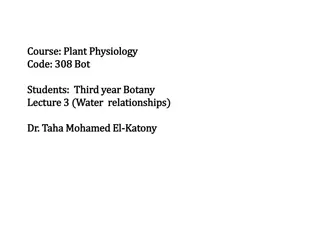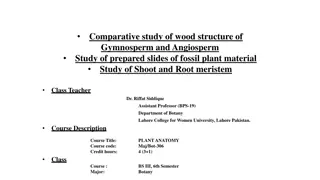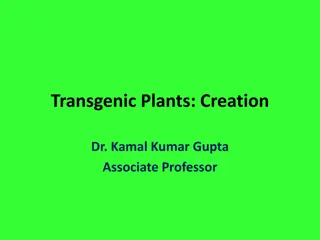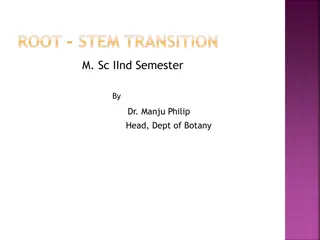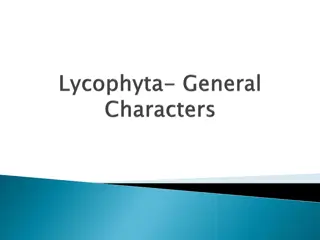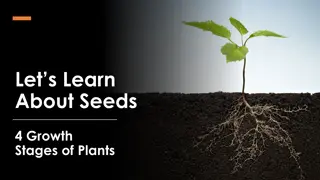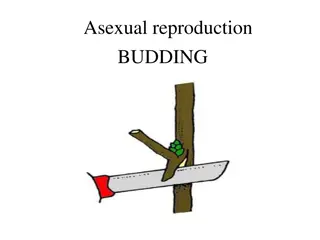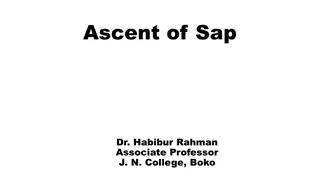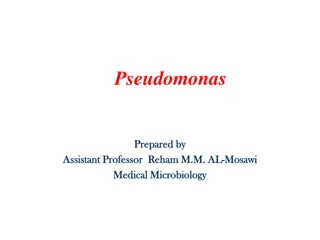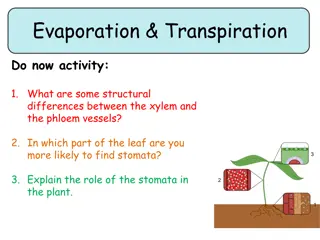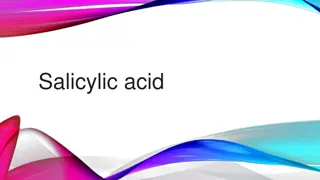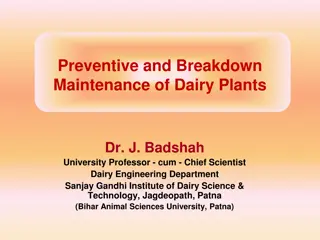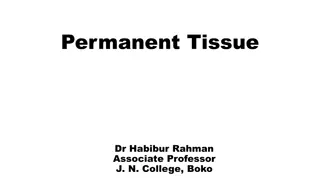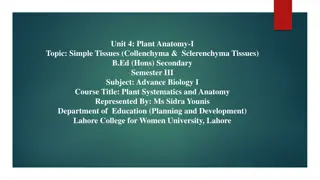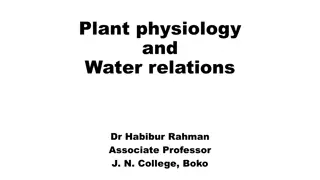Understanding the Morphology of Flowering Plants: Root and Shoot Systems and Plant Parts
Flowering plants have a typical structure comprising root and shoot systems. The root system is homogenous and consists of roots and branches, while the shoot system is also homogenous and includes the stem, branches, leaves, and flowers. The plant body is divided into vegetative and reproductive parts.
Download Presentation

Please find below an Image/Link to download the presentation.
The content on the website is provided AS IS for your information and personal use only. It may not be sold, licensed, or shared on other websites without obtaining consent from the author. Download presentation by click this link. If you encounter any issues during the download, it is possible that the publisher has removed the file from their server.
E N D
Presentation Transcript
MORPHOLOGY OFFLOWERING PLANTS CHAPTER 05,CLASS XIB
TYPICAL FLOWERING PLANT: Root System Shoot System Homogenous Consist of Roots and its Branches Homogenous Consist of Stem, branches , leaves, flowers PARTS OF PLANT BODY Vegetative Parts Reproductive Parts Responsible for Reproduction Flowers Promote Nutrition and Growth Root, Stem , Leaves
SOME INFORMATION : Study of external Structure of Plants:: ExternalMorphology Study of internal Structure of Plants: InternalMorphology ABOUT ROOTS: Positively Geotropic: grows downwards Negatively Phototropic: away fromlight Postively Hydrotropic :towards water Don t have Nodes Internodes FUNCTIONS: Fixation Anchorage (hold to soil) Nutrition( pass nutrients) Gas Exchanger( soil to plant) Food storer ( become swollen) Food manufacturer Aerial roots absorb moisture fromair
2. PARTS OF A ROOTAND THEIR FUNCTIONS
2.(A) TYPESOF ROOTS TapRoots FibrousRoots Develops from radicle Grow Vertically downwards into : Primary root Secondary Rootshorizontally Tertiary Roots Develops from any other part then Radicle They have equal sized growth of roots Also called Fibrous root system Present in Monocot plants Grow Roots are in Acropetal Succession Old at base, young at top Present in Dicotplants
1.MODIFICATIONS OFTAP-ROOTS: 2 (B) MODIFICATIONS OF ROOTS:
N: 1. Plants growing in marshy, swampy, salt lakes are called Halophytes 2. PROBLEM: Inability to respire in soil, as soil is water-logged 3. SOLUTION: Turn Negatively Geotropic and grow vertically upwards 4. Have special cells lenticels who respire
2. MODIFICATIONS OFADVENTITIOUS ROOTS: 1. FOOD STORAGE : FASCICULATED TUBEROUSROOTS ,e.g dahlia SIMPLE TUBEROUS ROOTS, e.g Sweet potato 1. Don t have definite shape 2. Arise from stem and dig into soil 1. Cluster of roots become fleshy (to store food) 2. Found at base of stem
2.FOR MECHANICAL SUPPORT 1.PROP ROOTS : 1. These Roots arise from branches 2. Grow downwards 3. FUNCTION: Provide mechanical support to heavy branches BANYAN TREE 2.STILT ROOTS: 1. Stems of such plants are weak 2. For that, Roots arise from stem and grown downwards to soil to give support MAIZE 3.CLIMBER ROOTS: Plants like such produce roots from nodes These roots attach themselves to any support and continue growing.
3.FOR SPECIALIZED FUNCTIONS : 1.EPIPHYTIC ROOTS: 1. Orchids like plants grow on branches to reach for sunlight 2. They have green leaves( so can photosynthesize), these plants called epiphytes HOST CUSCUTA 3. They have Velamen tissue inside which helps in absorption of moisture form air
2. SUCKING ROOTS /HAUSTORIUM : 1. Parasite plants attach to Host plants for feeding on their body. 2. In partial Parasitism, Plants penetrate Xylem only :Take water and minerals 3. In Whole Parasitism, penetrate Xylem: take water and minerals + Phloem :take foodaway HOST PARASTITE
5.1.2 MORPHOLOGY AND FUNCTIONS OF STEM: 1. Describe in Shoot system Aerial part of plant 2. Can be defined as , Ascending part :moves upwards develops from plumule divided In nodes and Internodes (refer diagram ) 3. Is, Positively Phototropic: Moves towards light Negatively Geotropicand Hydrotropic: moves away from soiland water
BUDS : YOUNG SHOOT CONTAINING YOUNGLEAVES There are two types of Buds Vegetative Buds: Buds which develop in branches Floral buds : buds developing in flowers ADVENTITIO US BUDS ACCESSORY BUDS (extra buds)
FUNCTIONS OF STEM: 1. Give Support to plant body 2. Conduct Water, Minerals 3.Food Transporter 4.Can also, store food, Proliferation and propogation, Produce support for climbing Offer protection ( spines) 5. 6. 7.
I) UNDERGROUND MODIFICATIONS : MODIFICATION OF STEMS : TUBER BULB RHIZOME CORM
III) AERIAL MODIFICATION OF STEM: STEM TENDRIL PHYLLOCADE BULBILS THORN cladode
PARTS OF A FOLIAGE : LAMINA PETIOLE LEAF BASE
MODIFICATIONS OF LEAVES: LEAFTENDRILS LEAF SPINES PHYLLODES LEAFHOOKS
RACEMOSE CYMOSE
TYPES OF INFLORESCENCES: In the racemose group, the florets, which are individual flowers in an inflorescence, bloom from the bottom of the stem and progress toward the top. Some examples of racemose inflorescence include spike, raceme, corymb, umbel, and head.
TYPES OF INFLORESCENCES: A spike is an inflorescence in which many stemless florets are attached to an elongated flower stem or peduncle, an example being gladiolus. A raceme is similar to a spike except the florets are borne on small stems attached to the peduncle.
TYPES OF INFLORESCENCE Raceme inflorescence with the flowers single on pedicels (stems) arranged along an elongated stem (rachis this is the stem between the flowers) alternate oldest are at the bottom and the youngest are at snapdragon, foxglove that is the top. Ex:
TYPES OF INFLORESCENCE Spike type of inflorescence with the flowers sessile (without a stalk) along the rachis. Ex: gladiolus Head a dense cluster of sessile or nearly sessile (no stalk) flowers on a very short rachis. Ex: sunflower, clover
Spike Gladiolus
Foxglove Snapdragon Raceme
Clover Sunflower Head
TYPES OF INFLORESCENCE Panicle inflorescence with two or more flowers on each branch which are attached to a rachis (elongated stem). Ex: wild oats, downy brome Corymb is made up of florets whose stalks and pedicles are random along the stalk in such a way that the florets create a flat, round top. Ex: yarrow arranged at
TYPES OF INFLORESCENCES: A corymb is made up of flowers that appear to be at the same level.the younger ones placed towards the center, As in mustard Yarrow has a corymb inflorescence. An umbel is similar except that the pedicels all arise from one point on the peduncle.
TYPES OF INFLORESCENCES: Dill has an umbel inflorescence. A head or composite inflorescence is made up of numerous stemless florets which is characteristic of daisy inflorescence. In the cyme group, the top floret opens first and blooms downward along the peduncle.
WILD OATS Downy Brome Panicle
CYMOSE INFLORESCENCE In the cyme group, the top floret opens first and blooms downward along the peduncle. OR A flower cluster in which the central flowers open first.
TYPES OF INFLORESCENCES: A dischasium cyme has florets opposite each other along the peduncle. A helicoid cyme is one in which the lower florets are all on the same side of the peduncle, examples being freesia and statice inflorescences.
Scorpoid Cyme: A determinate inflorescence with the lateral flowers born alternately on opposite sides


